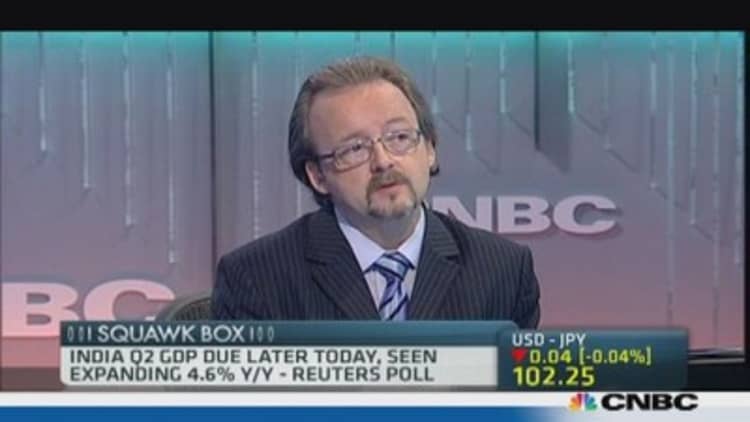After a rocky year for India's economy, the worst may finally be over and a steady acceleration in growth can be expected over the next fiscal year, according to Goldman Sachs.
An improvement in exports and an increase in investment demand should drive growth to 5.5 percent in the financial year ending March 31, 2015, the investment bank wrote in a note this week, up from an expected 4.3 percent in the current year.
(Read more: India tops China as most attractive investment venue)
Goldman expects India exports to be driven by a pick-up in the global economy and fall in the value of the rupee, which hit a record low of 68.85 to the U.S. dollar in August.
The bank also sees companies more willing to spend once the national elections expected by April/May next year is out of the way. In the previous election years of 2004 and 2009, industrial activity improved significantly in the six months following the vote compared to the six months prior to the polls, the bank observed.

"Upcoming elections may have delayed investment decisions by firms as they await the policies of the new government," said Goldman.
(Watch now: India to enter 2014 on a reasonably good footing)
"Investment spending will likely pick up from a very low base due to the removal of election uncertainty, and policy moves to de-bottleneck projects."
According to Goldman, India's Cabinet Committee on Investment - set up to fast track clearances for large projects - has approved 103 projects amounting to $57 billion. These will progressively come on-stream beginning in 2014 and contribute to a recovery in investment activity for the next few years.
On the consumption front, rural consumers will be key driver of spending, thanks to this year's better-than-expected monsoon, the bank added. Urban demand, in contrast, is likely to remain tepid due to a weak employment outlook.
(Read more: Will India break out of its downward growth spiral?)
Taper tantrum round two?

Goldman says the impact on India when the Federal Reserve finally scales back its asset purchases is unlikely to be as severe as during the summer of 2013 - when markets were roiled at the prospect of tapering - because asset prices have already moved considerably.
Back then, emerging market currencies, stocks and bonds suffered a dramatic selloff, with countries with perceived current account and fiscal deficits like India and Indonesia among the worst hit.
(Read more: Will Fedcrush emerging markets? The big debate)
Still, Goldman expects the Indian rupee to weaken further from current levels, albeit at a gradual pace.
Selling pressure could come from the closing of the currency swap window for oil firms, Goldman says. Following the sharp rupee depreciation in July and August, the Reserve Bank of India began supplying dollars to oil companies to meet their dollar requirements. When the swap period expires at the end of November, oil companies will sell dollars to the RBI to get back rupee.
(Read more: Onion crisis leaves trail of tears across India)
"While we think that higher inflation compared to trading partners may keep the rupee on a structurally depreciating path, an improving balance of payments may limit the extent of depreciation in the near term," the bank said.
The bank's 3-, 6- and 12-month dollar-rupee targets stand at 64, 65 and 65 respectively, compared with 62.4 currently.
—By CNBC's Ansuya Harjani; Follow her on Twitter:@Ansuya_H


